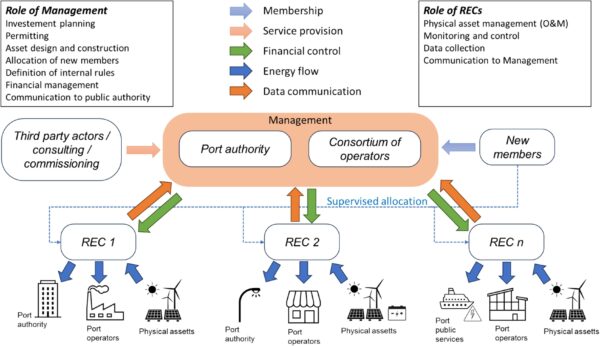Researchers from Italy's University of Naples Federico II have examined the feasibility of establishing renewable energy communities (RECs) in seaports. For that, they created a numerical model based on European Union regulations, though they say their results can be generalized to other ports. Taking the Port of Naples as a case study, they achieved a high self-consumption rate and low life cycle costs.
“Ports are particular anthropogenic systems characterized by high energy demands due to the multitude of activities conducted within the port areas, spanning electricity for shipping, industrial operations, and commercial facilities,” said the academics. “Therefore, through electrification of end-use and development of shared renewable energy projects under the enabling framework of RECs, ports can be transformed into renewable energy hubs, potentially supplying surplus energy to surrounding communities.”
Using software such as MATLAB and PVsyst, the scientists created a numerical model for the deployment of PV systems, wave energy converters (WECs), and battery energy storage systems (BESSs). They then modeled the system's financial flow and conducted multi-objective optimization to find the best REC configuration.
They built a case study on the Port of Naples, which has a potential PV installation area of 106,100 m2, while the WECs are assumed to be located on the port's breakwaters, extending 1.5 km. A typical year's meteorological data was used from irradiation and wave profiles. The location receives a maximum of approximately 1,000 Wh/m2 of global horizontal radiation, to an annual radiation of about 1,600 kWh/m2. The maximum wave height reaches 2.5 m, with an average of 0.55 m.
“The analysis considers south-facing solar panels with an azimuth angle of 0 degrees and a slope angle of 30 degrees, utilizing commercial photovoltaic modules rated at 315 W per module,” explained the researchers. “An oscillating water column (OWC) system is assumed as the chosen technology for harnessing wave energy.”
The assumed capital costs for PV at €1,200 ($1.295)/kW, €1,500 /kW for WEC, and €350/kW for BESS. The model considered PV facilities of up to 12 MW, WEC of up to 5 MW, and BESS of up to 5 MWh.

Image: University of Naples Federico II, Energy Conversion and Management, CC BY 4.0
In addition, the study considered seven RECs that can work together or separately. Port authority REC (PA REC) consists mainly of the public area, while REC 1-5 are entities grouped together based on their proximity. Port REC refers to one large energy community of the whole port, with a peak demand of 3,800 kW.
“According to information publicly provided by the port authority, the main actors operating within the port's boundaries can be grouped into general companies, passenger sector operators, shipyards, and commercial operators. All of them are energy users and potential stakeholders in the establishment of RECs,” emphasized the researchers.
According to them, optimizing the system would enable a port REC with 90% self-consumption and 60% self-sufficiency. That yields a life cycle cost (LCC) for 20 years of €35 million, considering that port operators would have spent €86 million otherwise. BESS leads to a 15% increase in self-consumed energy.
“The decision between creating one or more RECs in port depends on specific port characteristics,” concluded the academics. “Optimization results showed that multiple RECs provide more total incomes and lead to lower LCC (€19 million compared to €35 million) compared to implementing a single REC in ports. However, virtual self-consumption slightly decreases to 81%.”
The researchers suggested that “the complexity of managing renewable energy assets in ports may be addressed by centralized management of multiple RECs in ports by a synergy among Port Authority, port operators, members of the RECs and third-party actors. We proposed a management model that involves all of them and introduces a supervised allocation of new members, dividing the management roles between the central management and individual RECs. In this way, ports can offer more competitive and cost-effective services to port users.”
Their findings were presented in “Empowering sea ports with renewable energy under the enabling framework of the energy communities,” published on Energy Conversion and Management. Scientists from Canada's Concordia University were also involved in the study.
This content is protected by copyright and may not be reused. If you want to cooperate with us and would like to reuse some of our content, please contact: editors@pv-magazine.com.



By submitting this form you agree to pv magazine using your data for the purposes of publishing your comment.
Your personal data will only be disclosed or otherwise transmitted to third parties for the purposes of spam filtering or if this is necessary for technical maintenance of the website. Any other transfer to third parties will not take place unless this is justified on the basis of applicable data protection regulations or if pv magazine is legally obliged to do so.
You may revoke this consent at any time with effect for the future, in which case your personal data will be deleted immediately. Otherwise, your data will be deleted if pv magazine has processed your request or the purpose of data storage is fulfilled.
Further information on data privacy can be found in our Data Protection Policy.